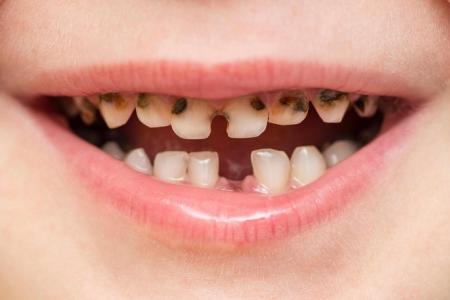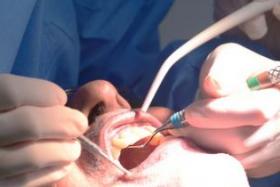About 1 in 2 children here has tooth decay by kindergarten age
The child was not even five when paediatric dentist Bien Lai Wen Pui pulled out all 20 of his baby teeth while he was under general anaesthesia.
He had no teeth until new adult ones emerged at the age of seven.
“They were all rotten and causing him a lot of pain. Sometimes when you extract the bad teeth, the child can eat better,” said Dr Bien Lai, who heads the Paediatric Dentistry Unit at the National Dental Centre Singapore (NDCS).
To prevent such extractions, NDCS started its Infant Oral Health Programme in April 2024 to help parents understand that tooth decay in very young children can largely be preventable.
The programme is part of its Paediatric Population Oral Health Initiatives to direct efforts upstream by increasing oral health awareness and promoting healthy dietary and oral health habits from an early age.
Since its inception, over 300 children have benefited from this early intervention.
Tooth decay, formally known as early childhood caries (ECC), is the most prevalent chronic disease in children that is largely preventable.
About one in two children in Singapore suffers tooth decay by the time they enter kindergarten, according to NDCS. This is an increase from two in five found in the 2009 study.
The impacts are considerable said Dr Bien Lai: “When a child has too many cavities, it may be difficult for him or her to brush the teeth well, resulting in food (being) trapped and causing tooth decay to worsen. Untreated tooth decay also results in pain, swelling, bad breath, missed school days due to pain or the need to go for dental appointments, affects diet and sleep, and growth and development.”
Dr Bien Lai pointed out that the data of one in two children is actually based on a local study that was published in 2014.
“(Unfortunately), we do not carry out regular epidemiology studies in Singapore to track the prevalence of tooth decay in pre-school children. However, for school-age children, we do,” she added.
This is because of the Youth Preventive Dental Service for primary and secondary school students, which allows tracking of their dental health.
Unfortunately, the two studies did not compare apples to apples.
“(In the 2014 study), the participants looked at were actually younger – two- to four-year-olds. The earlier one looked at five- and six-year-olds,” Dr Bien Lai explained.
According to her, parents often focus on their child’s well-being and physical, emotional and developmental needs while overlooking oral health which is a critical aspect of health.
Dental caries, particularly in young children, is often dismissed as a temporary issue, she added.
“After all, baby teeth fall out, right?” Dr Bien Lai said, describing many parents’ perception.
“However, the consequences of ECC go far beyond cavities. Baby teeth are essential for proper nutrition, speech development, and guiding the growth of permanent teeth. Without proper care, tooth decay in baby teeth can lead to complications that may be more difficult to manage,” she added.
NDCS found that only 8 per cent of children aged three to six years old and 3 per cent of children aged 18 to 48 months received regular dental care.
Dr Bien Lai said parents should start oral hygiene habits even before their child’s first tooth and ideally, take the child to see the dentist when he or she is between six and 12 months of age. This allows the dentist to prevent and anticipate problems rather than treat them.
Tooth decay happens when tooth decay risks outweigh protective factors, and Dr Bien Lai said that over time, the fight against tooth decay gets harder as there are so many risk factors, such as the types sugary snacks and drinks available and the frequency of consumption.
Allowing babies to fall asleep on the bottle, which leaves the teat in the mouth, is another contributor to poor dental health: “Here, even the kind of milk matters. Not every single kind of milk the baby sucks in a bottle would cause decay. (It depends) on the sugar content as well as the duration of the milk bottle being in the mouth.”
The children who go to NDCS for dental care typically have a lot to tooth decay.
“(By then,) the damage has already been done, so a lot of the time, what we do is actually more curative (work) than preventive,” Dr Bien Lai said.
To carry out preventive work, NDCS is working with its community partners “to try and catch children who are at high risk of tooth decay earlier, and teach the parents what are the high risk habits and behaviours that they can modify on their own”.
Some of these collaborators include pre-school teachers and community nurses at the healthcare social hubs.
Even in a more recent multi-institutional study in Singapore, published in 2020 by Europe PMC, which provides free access to biomedical and life sciences research articles, caries risk assessment models for toddlers and pre-schoolers are rare.
The study found that past caries experience is a consistent predictive factor for future caries risk among this group of children.
That is why Dr Bien Lai said the team will also encourage doctors and nurses at the polyclinics to include oral health in some of their developmental assessments.
“When the children go for vaccination, (polyclinic staff) will do some development assessments, like when children are five months old, a year old; so we want to incorporate oral health into some of these assessments,” she said.
As for the boy who had 20 of his milk teeth pulled out at the same time, he is much older now and has a set of healthy adult teeth, said Dr Bien Lai. He is followed up regularly at her department at NDCS.
Get The New Paper on your phone with the free TNP app. Download from the Apple App Store or Google Play Store now


